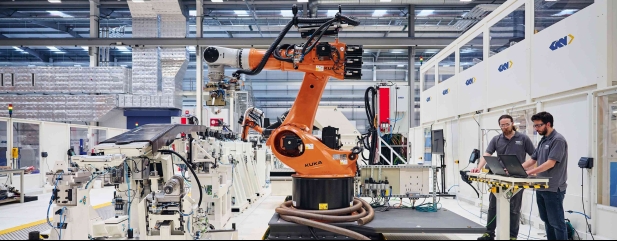Archived article
Please note that tax, investment, pension and ISA rules can change and the information and any views contained in this article may now be inaccurate.
Aerospace and defence group Melrose aims for the stars with its 2029 targets

Melrose Industries (MRO) 523p
Market cap: £6.8 billion
It’s not often you see a FTSE 100 company lose nearly 30% of its market value in just two days, but that’s what happened earlier this month when aerospace and defence firm Melrose (MRO) published its preliminary 2024 results.
It didn’t matter that earnings were better than forecast, or that the firm issued upbeat growth forecasts for the next five years, the market decided it didn’t like the statement and wiped a couple of billion pounds off the company’s value.
We think the reaction was overdone and the shares now offer good value for investors willing to take a longer-term view on a high-quality, tier-one aerospace supplier.
BEAT AND RAISE
While the Melrose of old was known for its ‘buy, improve, sell’ model, today the group is a pure aerospace play with a high-margin manufacturing business and an aftermarket sales and servicing business which is growing strongly.
It operates two divisions, Engines – which generated around £1.5 billion of revenue last year with an operating margin of 28.9% – and Structures, which generated around £2 billion of revenue last year with a 7.2% margin.
The Engine business leads the industry in the manufacture of advanced structures, cases and frames, and is a risk- and revenue-sharing partner on 19 engine programmes covering some 70% of major civil aircraft flight hours globally.
The company estimates over 100,000 flights each day involve aircraft with some of its technology on board.
It also supplies the engines for the Saab Gripen fighter and engine parts for the F-35, although defence – which is obviously a hot topic nowadays – represents just 28% of revenue against 72% for civil work.
In Structures, Melrose has ‘design-to-build’ expertise in lightweight composite and metallic components for airframes as well as electrical wiring interconnection systems, and it has moved into ‘additive manufacturing’.
Despite supply constraints impacting the construction of new aircraft, sales and earnings were comfortably above estimates for the year to December largely thanks to a strong after-market where revenue grew 32%.
As domestic and international air traffic continues to rise, along with passenger loads, total 2024 flight hours were above 2023 levels and above pre-pandemic levels, meaning more aircraft needed engine shop visits and spares.
And, with average aircraft life increasing and no new engine programmes due to start before the end of this decade, maintenance and servicing needs are only going to grow.
As a result, Melrose sees group revenue rising to £5 billion in 2029, operating profit rising to more than £1.2 billion (implying a group margin of over 24%) and EPS (earnings per share) growing at a compound annual rate of 24% which is radically higher than in the past.
CASH MISMATCH
A big part of future cash flow – some £22 billion according to the company – is set to come from Engine risk-and-revenue-sharing partnerships (RRSPs) which guarantee after-market profits across various engine families, but investors have often struggled to get their heads round this.
According to some commentators, the sell-off in the share price on results day was due to a perceived mismatch between cash flow and reported earnings under the IFRS 15 accounting standard.
The company has even produced a booklet and held a teach-in for investors to explain why, under IFRS 15, it has to report a proportion of its future aftermarket income as ‘variable consideration’.
‘This is due to a combination of specific contractual rights and the nature of our components in these partnerships, which typically last the lifetime of the engine,’ explains the firm.
‘The variable consideration, which is currently around a quarter of our overall RRSP revenue, effectively recognises or pulls forward a percentage of our future contractually entitled aftermarket income and treats it as revenue at the point of delivery of our components.’
With work from these partnerships set to ramp up as engines need more aftermarket parts, the variable consideration will rise and there will continue to be a mismatch between reported profit under IFRS 15 and cash, but in this respect Melrose is no different to any other firm in the same situation and we see no reason to be concerned.
UPGRADES COMING THROUGH
Analysts at Barclays’ investment bank raised their price target from 650p to 730p and repeated their ‘overweight’ (buy) call on the shares, while RBC responded to the raised guidance by hiking its earnings per share forecasts and adding a 760p price target.
‘While the share has not reacted well, we see the update as highly supportive of consensus. The 2029 targets are 20% above consensus, with the free cash-flow guide in particular a clear support,’ said the team at RBC.
Considering the firm’s ambitious targets, with the operating margin seen topping 24% against 16% currently and EPS growing at a 20%-plus rate, we think the risk-reward trade-off looks highly favourable.
An easy win would be for the firm to rebrand itself as GKN Aerospace, as the business has moved on and the old Melrose monicker no longer seems relevant.
Important information:
These articles are provided by Shares magazine which is published by AJ Bell Media, a part of AJ Bell. Shares is not written by AJ Bell.
Shares is provided for your general information and use and is not a personal recommendation to invest. It is not intended to be relied upon by you in making or not making any investment decisions. The investments referred to in these articles will not be suitable for all investors. If in doubt please seek appropriate independent financial advice.
Investors acting on the information in these articles do so at their own risk and AJ Bell Media and its staff do not accept liability for losses suffered by investors as a result of their investment decisions.
Issue contents
Feature
Great Ideas
Investment Trusts
News
- ASOS shares hit new all-time low despite US restructuring news
- Greatland Gold shares gain 53% year-to-date as bullion price hits new high
- Stagflation fears stoked by stalling consumer confidence and rising inflation
- Vistry expected to draw a line under cost issues and provide new medium-term targets
- Threat of Asda-led price war puts supermarket shares under pressure
 magazine
magazine








